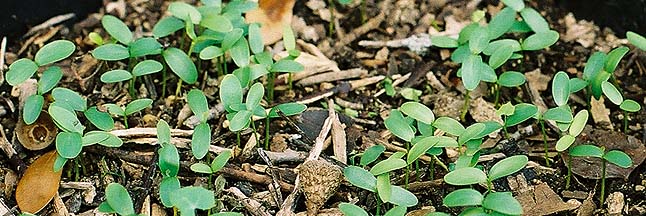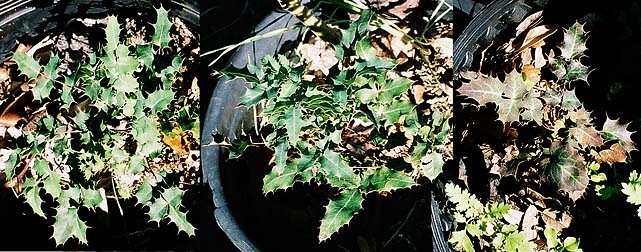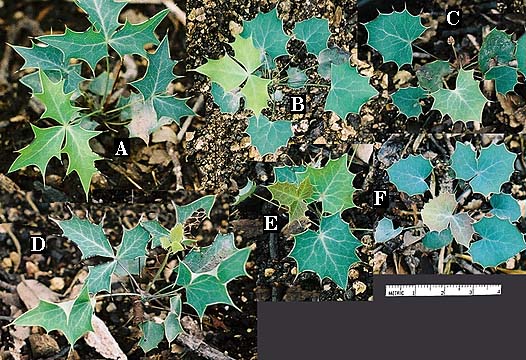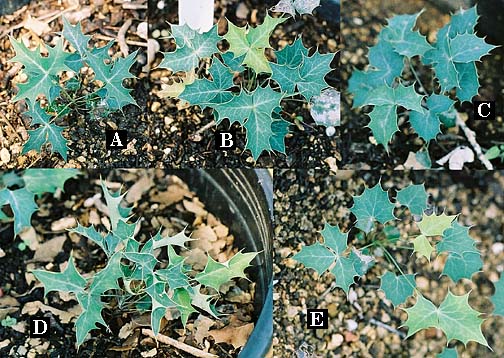To Berberis Home

B. trifoliolata germination, Dec. 29, 2004
Seed Fertility
by Bob Harms

Seeds of both species and of the hybrids all exhibit the same degree of fertility, as indicated by:
Germination
A high rate of germination was obtained by extracting and washing seeds from ripe fruits and immediately storing them in the refrigerator:
- stratified in moist sand in plastic containers;
- in paper envelopes (not moist).
2002 Seed Germination Trial
In late June 2002 B. swaseyi seeds were stratified as above, with the intention of planting in December for spring germination. When I opened the containers on Dec. 1, I discovered that:
- virtually 100 percent germination had occurred already in the stratification containers with those seed sets I had marked 'pale,' from both hollow (60 seeds) and juicy (40 seeds) fruits
- no change had occurred with seed sets marked 'float' (90 seeds, from hollow fruits) or 'dark' (125 seeds, from juicy fruits)
But as of February 2003 all but one or two in the germinating set had died off. I assume this was because of the cold winter and the tender status of the seedlings which had germinated in the dark and had been moved to outside pots.

B. swaseyi germinated early spring 2003.
A third set of seeds which were not stratified were planted in the fall and these germinated in early spring, although not in such large numbers, and did well in pots until they were moved into the ground in January 2005.
2004 Seed Germination Trial
Apparent fertile seeds were collected in spring 2004 from all known hybrids with mature fruit (7 plants), one suspected 3-foliate hybrid (T23) and one B. swaseyi (S22). These were stratified as above and inspected on July 31 after 6—10 weeks in hopes of avoiding the storage germination that had occurred in 2002. Even so, limited germination had already occurred in storage (two hybrids had not germinated and one hybrid had numerous seedlings with roots c. ¾" long). All seeds and seedlings were immediately moved to shaded outdoor pots at that time. Many seedlings disappeared in August until I discovered that a small grasshopper had taken up residence between the pots.
Seeds from various B. trifoliolata (BETR) and B. swaseyi (BESW) plants (not distinguished) plus plant S2B were kept dry in the refrigerator and were planted the first week of October. These first germinated in November and continued through February. Overall the BESW sets showed less germination than BETR.
All fall—winter seedlings survived hard frosts (c. 20° F), although some of the first true leaflets on BETR exhibited the maroon shift typical of B. swaseyi.
| | Number of Seedlings |
| 8/10/04 | 10/28/04 | 4/23/05 | 4/30/05¹ |
| H1 | 3 | 3 | - | 3 |
| H2 | - | 6 | 16
one dead | 14 |
| H4 | 9 | 5 | - | 4 |
| H6 | 6 | 3 | - | 3 |
| H8 | 5 | 4 | - | 4 |
| H11 | 1
many dead | 2 | - | 3 |
| H12 | 1 | - | - | - |
| S22 | 2 | - | - | 16 |
| T23 | 14 | 12 | - | 12 |
Seeds from dry storage planted first week of October 2004
— germination from November to February.
|
| BETR | 2 | - | 15+ |
| BESW | 64 |
| S2B | 13 |
¹On 4/30/04 seedlings were repotted to allow greater room for growth. Only some 15 BETR were repotted;
the rest were moved directly into the ground, but none of these survived.
Shown below are photographs taken August 11, 2005, of 1-year seedlings from T23 and five different hybrid sets. They are labeled A to E in order to allow the reader an opportunity to pick out the T23 seedling. Identification and larger images are given on a separate page.

Click here to see the key to Aug. 11 seedling parentage.
And c. 7 weeks later, September 22, 2005, seedlings from T23 and and four hybrid sets was photographed. These too are labeled A to E in order to allow the reader an opportunity to identify the T23 seedling. Identification and larger images are given on a separate page.

Click here for the key to Sept. 22 seedling parentage
